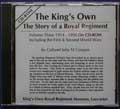 |
King's Own Royal Regiment Museum Lancaster |
|||
|
HOME Museum & Collections Soldiers of the Regiment Sales Donations Events Contact Us REGIMENTAL HISTORY 17th Century 18th Century 19th Century 20th Century First World War Second World War Actions & Movements Battle Honours FAMILY HISTORY Resources Further Reading PHOTO GALLERY ENQUIRIES FURTHER READING LINKS |
Regimental History - 20th Century Second World War 1939-1945 5th Battalion, King's Own Royal Regiment, Lancaster The 5th Battalion (Territorial Army) of the King's Own Royal Regiment recruited from North Lancashire and had Drill Halls in places such as Fleetwood, Carnforth, Morecambe and Lancaster. The Battalion was mobilised in September 1939 as part of the 42nd (East Lancashire) Division of the TA, which in April 1940 joined the British Expeditionary Force in France. After the German invasion on 10th May the battalion withdrew to Dunkirk and provided the defence on a section of the Dunkirk perimeter before being evacuated. On return to the UK the unit was employed on anti-invasion duties. In January 1942 the Battalion was converted to Armour and became 107th Regiment, Royal Armoured Corps (The King's Own) 4th September 1939 Mobilised for service The battalion mobilised and concentrated at Carnforth, north of Lancaster, under their commanding officer Lieutenant-Colonel G Oglethorpe. The unit was under-strength, having already lost men who were underage or medically unfit for overseas service. 29th September 1939 Moved to Northumberland The 5th Battalion moved with the rest of the Division to Northumberland. October 1939 New men arrive with Battalion Towards the end of October the battalion was strengthened with the first draft of militiamen, who had by now completed their basic training. On the 5th November 1939 Battalion Headquarters moved from Wooler to Milfield in North Northumberland. 'A' Company was based at Doddington; 'B' and 'C' Companies at Lowick; 'D' Company at Barmoor Castle, near Lowick, all North Northumberland. On 3rd December 1939, twenty five other ranks proceeded to the Royal Army Service Corps School at Whitley Bay for Motor Transport Driving Course. On 6th December 1939, an aeroplane crashed near Longframlington, the plane was a total wreck and the pilot had escape by parachute. 'D' Company mounted a guard over the wreckage. 2nd April 1940 Battalion leaves for France and Belgium The advance party left the UK for France and Belgium with the main body following within the next couple of days. 10th May 1940 – 2nd June 1940 Action in France and Belgium On the 10th May the German armies began their advance. They swept through Holland and Belgium and, by 12th May, the French line of defence - the Maginot Line - was broken. They seemed unstoppable. The British Expeditionary Force included the following King's Own units: 5th Territorial Battalion, 6th, 7th, 8th and 9th Pioneer Battalions and the 56th Anti-Tank Regiment. The 5th Battalion were to retreat to Dunkirk and help form the defensive perimeter around the Port of Dunkirk whilst others were evacuated between 26th May and 4th June. By 2nd June most of the King's Own men had embarked for England. At 9am on the 4th June Dunkirk was surrendered to the Germans. 10th May 1940 - Manning post at Le Touquet. 24th May 1940 Enemy Aircraft Attack The battalion was attacked by 24 German aircraft. During this attack Drummer J Whitbread fired a Bren gun forcing the aircraft to break formation and desist from their attacks. The next day the decision was made to evacuate the BEF through Dunkirk and the 5th Battalion were ordered to hold the line at the River Marcq at Bouvines as part of the 42nd Division. 30th May 1940 Battalion leaves Yser The 5th Battalion was the last unit of the 42nd Division to withdraw from Yser. They were then moved to Divisional Reserve at Dunkirk. 1st June 1940 Departure from France The majority of the battalion embark on HMS Locust, which arrives at Dover on 2nd June. 3rd June 1940 - August 1940 Home Defence The 5th Battalion arrived back in England at Dover and are pressed to service in a Home Defence roll. At first operating in the North East and Yorkshire in camouflaged buses. 14th August 1940 - The 5th Battalion was headquartered in Thirsk, North Yorkshire, and for the first time had a day time air raid warning. 17th August 1940 - The Battalion was digging slit trenches at Thirsk Racecourse and Skelfield School. 19th August 1940 - The Commanding Officer exercised both the motor cycle platoon and Molotoff Platoon. The 'Molotoff' platoon was equipped with improvised bombs, made from petrol filled glass bottles, with a ignitable rag in the top. The name originates from the Finns in the Winter War against the Soviet Union, when Molotoff [Molotov] was the Soviet Foreign Minister. 29th August 1940 - The Commanding Officer exercised both the Molotoff and Carrier Platoons. 31st August 1940 - The battalion undertook training at company level. 5th September 1940 Division moves from Yorkshire The 42nd Division, or which the 5th Battalion was part, moved from Yorkshire to Gloucestershire and the 5th King's Own were based at Winchcombe. 20th September 1940 Move to Maidenhead The 5th Battalion moved to Maidenhead and live under canvas. December 1941 Battalion converted to armour The 5th Battalion ceased being an infantry battalion and were converted to the 107th Regiment Royal Armoured Corps (The King's Own). The battalion was to be equipped with Churchill tanks. As the unit had direct origins with the King's Own they were entitled to wear the King's Own lion cap badge.
Only a proportion of our collections are on display at anyone time. Certain items are on loan for display in other institutions. An appointment is required to consult any of our collections which are held in store. |

